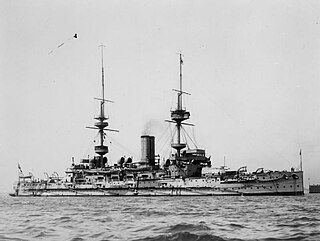
The third HMS Illustrious of the British Royal Navy was a Majestic-class pre-dreadnought battleship. The ship was built at the Chatham Dockyard; her keel was laid down in March 1895, her completed hull was launched in September 1896, and she was commissioned into the fleet in April 1898. She was armed with a main battery of four 12-inch (305 mm) guns and a secondary battery of twelve 6-inch (152 mm) guns. The ship had a top speed of 16 knots.

The Royal Sovereign class was a group of eight pre-dreadnought battleships built for the Royal Navy in the 1890s. The ships spent their careers in the Mediterranean, Home and Channel Fleets, sometimes as flagships, although several were mobilised for service with the Flying Squadron in 1896 when tensions with the German Empire were high following the Jameson Raid in South Africa. Three ships were assigned to the International Squadron formed when Greek Christians rebelled against the Ottoman Empire's rule in Crete in 1897–1898.
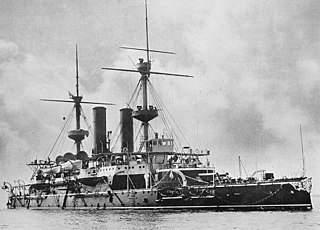
HMS Hood was a modified Royal Sovereign-class pre-dreadnought battleship built for the Royal Navy in the early 1890s. She differed from the other ships of the class in that she had cylindrical gun turrets instead of barbettes and a lower freeboard. She served most of her active career in the Mediterranean Sea, where her low freeboard was less of a disadvantage. The ship was placed in reserve in 1907 and later became the receiving ship at Queenstown, Ireland. Hood was used in the development of anti-torpedo bulges in 1913 and was scuttled in late 1914 to act as a blockship across the southern entrance of Portland Harbour after the start of World War I.

HMS Victorious was one of nine Majestic-class pre-dreadnought battleships of the British Royal Navy. She was armed with a main battery of four 12-inch (305 mm) guns in two twin turrets, and was capable of a top speed of 16 knots. She served primarily on home waters, and participated in the Fleet Review for the Diamond Jubilee for Queen Victoria in 1897. She served briefly in the Mediterranean in 1898 before being transferred to the China Station later that year; Victorious remained in East Asian waters until 1900, when she returned to the Mediterranean.

HMS Venerable (1899) was a member of the London class of pre-dreadnought battleships built for the British Royal Navy. The Londons were near repeats of the preceding Formidable-class battleships, but with modified armour protection. Venerable's main battery consisted of four 12-inch (305-mm) guns, and she had top speed of 18 knots. The ship was laid down in January 1899, was launched in November that year, and was completed in November 1902. Commissioned that month, Venerable served in the Mediterranean Fleet until 1908, and was subsequently recommissioned into the Channel Fleet. Following a major refit in 1909, she served with the Atlantic and Home Fleets.

HMS Magnificent was one of the nine Majestic-class pre-dreadnought battleships of the Royal Navy. She entered service in late 1895 with the Channel Fleet, remaining with the fleet through its subsequent reorganisation into the Atlantic Fleet. In 1905, an explosion caused the deaths of 18 men but she remained in service until 1906, after which she underwent a refit. She served with the Home Fleet for most of her pre-war service.
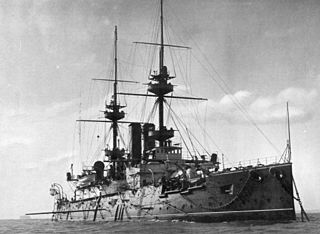
HMS Jupiter was a Majestic-class pre-dreadnought battleship of the Royal Navy. Commissioned in 1897, she was assigned to the Channel Fleet until 1905. After a refit, she was temporarily put in reserve before returning to service with the Channel Fleet in September 1905. In 1908 and rendered obsolete by the emergence of the dreadnought type of battleships, she once again returned to the reserve, this time with the Home Fleet. After another refit, she had a spell as a gunnery training ship in 1912.

HMS Resolution was a Royal Sovereign-class pre-dreadnought battleship of the Royal Navy. The ship was built by Palmers Shipbuilding and Iron Company, starting with her keel laying in June 1890. She was launched in May 1892 and, after completing trials, was commissioned into the Channel Squadron the following December. She was armed with a main battery of four 13.5-inch guns and a secondary battery of ten 6-inch guns. The ship had a top speed of 16.5 knots.

HMS Swiftsure, originally known as Constitución, was the lead ship of the Swiftsure-class pre-dreadnought battleships. The ship was ordered by the Chilean Navy, but she was purchased by the United Kingdom as part of ending the Argentine–Chilean naval arms race. In British service, Swiftsure was initially assigned to the Home Fleet and Channel Fleets before being transferred to the Mediterranean Fleet in 1909. She rejoined Home Fleet in 1912 and was transferred to the East Indies Station in 1913, to act as its flagship.

HMS London was the lead ship of the London class of pre-dreadnought battleships built for the British Royal Navy. The Londons were near repeats of the preceding Formidable-class battleships, but with modified armour protection. The ship was laid down in December 1898, was launched in September 1899, and was completed in June 1902. Commissioned the same month, she served with the Mediterranean Fleet until early 1907. She was assigned to the Nore Division of the Home Fleet for nearly a year before transferring to the Channel Fleet. Rendered obsolete with the emergence of the new dreadnoughts in late 1906, she underwent an extensive refit in 1909, after which she served with the Atlantic Fleet. She was assigned to the Second Home Fleet in 1912 as part of the 5th Battle Squadron, and was temporarily fitted with a makeshift ramp for experiments with naval aircraft until 1913.

HMS Revenge was one of seven Royal Sovereign-class pre-dreadnought battleships built for the Royal Navy during the 1890s. She spent much of her early career as a flagship for the Flying Squadron and in the Mediterranean, Home and Channel Fleets. Revenge was assigned to the International Squadron blockading Crete during the 1897–1898 revolt there against the Ottoman Empire. She was placed in reserve upon her return home in 1900, and was then briefly assigned as a coast guard ship before she joined the Home Fleet in 1902. The ship became a gunnery training ship in 1906 until she was paid off in 1913.

HMS Repulse was one of seven Royal Sovereign-class pre-dreadnought battleships built for the Royal Navy in the 1890s. Assigned to the Channel Fleet, where she often served as a flagship, after commissioning in 1894, the ship participated in a series of annual manoeuvres, and the Queen Victoria's Diamond Jubilee Fleet Review during the rest of the decade. Repulse was transferred to the Mediterranean Fleet in 1902 and remained there until December 1903, when she returned home for an extensive refit. After its completion in 1905, Repulse was assigned to the Reserve Fleet until she was sold for scrap in 1911.

HMS Royal Sovereign was the lead ship of the seven ships in her class of pre-dreadnought battleships built for the Royal Navy in the 1890s. The ship was commissioned in 1892 and served as the flagship of the Channel Fleet for the next five years. She was transferred to the Mediterranean Fleet in 1897 and returned home in 1902, and was briefly assigned as a coast guard ship before she began a lengthy refit in 1903–1904. Royal Sovereign was reduced to reserve in 1905 and was taken out of service in 1909. The ship was sold for scrap four years later and subsequently broken up in Italy.
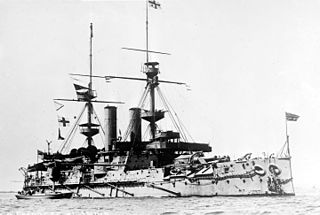
HMS Empress of India was one of seven Royal Sovereign-class pre-dreadnought battleships built for the Royal Navy during the 1890s. The ship was commissioned in 1893 and served as the flagship of the second-in-command of the Channel Fleet for two years. She was transferred to the Mediterranean Fleet in 1897, during which time Empress of India was assigned to the International Squadron blockading Crete during the uprising there. She returned home in 1901 and was briefly assigned as a coast guard ship in Ireland before she became the second flagship of the Home Fleet. The ship was reduced to reserve in 1905 and accidentally collided with the submarine HMS A10 the following year. Empress of India was taken out of service in early 1912 and accidentally struck a German sailing ship while under tow. She was sunk as a target ship in 1913.

HMS Ramillies was a Royal Sovereign-class pre-dreadnought battleship of the Royal Navy, named after the Battle of Ramillies. The ship was built by J. & G. Thompson at Clydebank, starting with her keel laying in August 1890. She was launched in March 1892 and commissioned into the Mediterranean Fleet as flagship the following October. She was armed with a main battery of four 13.5-inch guns and a secondary battery of ten 6-inch guns. The ship had a top speed of 16.5 knots.

The Centurion-class battleships were a pair of pre-dreadnought battleships built for the Royal Navy in the 1890s. They were rated as second-class battleships because they were less heavily armed and armoured than the first-class battleships. They were designed for service abroad and were given higher speed and longer range to counter the armoured cruisers then being built as commerce raiders.

HMS Centurion was the lead ship of her class of two pre-dreadnought battleships built for the Royal Navy in the 1890s. Intended for service abroad, they exchanged heavy armour and a powerful armament for high speed and long range to counter the foreign armoured cruisers then being built as commerce raiders and were rated as second-class battleships.

HMS Barfleur was the second and last of the Centurion-class pre-dreadnought battleships built for the Royal Navy in the 1890s. Intended for service abroad, they exchanged heavy armour and a powerful armament for high speed and long range to counter the foreign armoured cruisers then being built as commerce raiders and were rated as second-class battleships.

HMS Renown was a second-class predreadnought battleship built for the Royal Navy in the early 1890s. Intended to command cruiser squadrons operating on foreign stations, the ship served as the flagship of the North America and West Indies Station and the Mediterranean Fleet early in her career. Becoming obsolete as cruiser speeds increased, Renown became a royal yacht and had all of her secondary armament removed to make her more suitable for such duties. She became a stoker's training ship in 1909 and was listed for disposal in 1913. The ship was sold for scrap in early 1914.
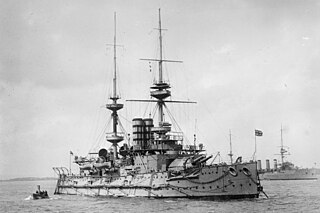
HMS Mars was a Royal Navy pre-dreadnought battleship of the Majestic class, the seventh member of a class of nine ships. The ship was laid down in the Laird Brothers shipyard in June 1894, she was launched in March 1896, and she was commissioned into the fleet in June 1897. She was armed with a main battery of four 12-inch (305 mm) guns and a secondary battery of twelve 6-inch (152 mm) guns. The ship had a top speed of 16 knots.




















